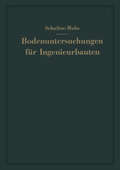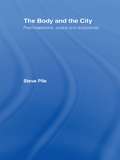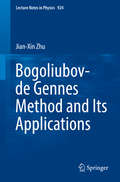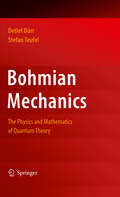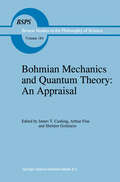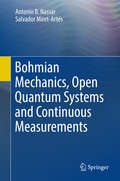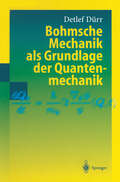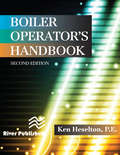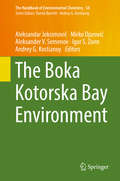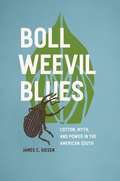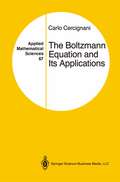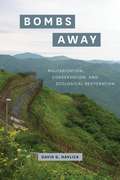- Table View
- List View
Bode’s Law and the Discovery of Juno: Historical Studies in Asteroid Research
by Clifford J. CunninghamJohann Bode developed a so-called law of planetary distances best known as Bode’s Law. The story of the discovery of Juno in 1804 by Karl Harding tells how Juno fit into that scheme and is examined as it relates to the philosopher Georg Hegel’s 1801 thesis that there could be no planets between Mars and Jupiter. By 1804 that gap was not only filled but had three residents: Ceres, Pallas and Juno! When Juno was discovered no one could have imagined its study would call into question Newton’s law of gravity, or be the impetus for developing the mathematics of the fast Fourier transform by Carl Gauss. Clifford Cunningham, a dedicated scholar, opens to scrutiny this critical moment of astronomical discovery, continuing the story of asteroid begun in earlier volumes of this series. The fascinating issues raised by the discovery of Juno take us on an extraordinary journey. The revelation of the existence of this new class of celestial bodies transformed our understanding of the Solar System, the implications of which are thoroughly discussed in terms of Romantic Era science, philosophy, poetry, mathematics and astronomy. The account given here is based on both English and foreign correspondence and scientific papers, most of which are translated for the first time.
Bodies: Exploring Fluid Boundaries (Critical Geographies)
by Robyn LonghurstThis is one of the first books to introduce students to the key concepts and debates surrounding the relationship between bodily boundaries, abject materiality and spaces. The text includes original interview and focus group data informed by feminist theory on the body and uses case studies to illustrate the social construction of bodies. It will critically engage students in topical questions around sexuality, cultural differences and women's sub-ordination to men.
Bodies: Exploring Fluid Boundaries (Critical Geographies)
by Robyn LonghurstThis is one of the first books to introduce students to the key concepts and debates surrounding the relationship between bodily boundaries, abject materiality and spaces. The text includes original interview and focus group data informed by feminist theory on the body and uses case studies to illustrate the social construction of bodies. It will critically engage students in topical questions around sexuality, cultural differences and women's sub-ordination to men.
Bodies, Affects, Politics: The Clash of Bodily Regimes (RGS-IBG Book Series)
by Steve PileThis book seeks to understand the coexistence of bodily regimes and the politics that emerge from the clash between them: Presents a novel conceptual model for understanding the relationship between bodies and affects Reworks Rancière's notions of the distribution of the sensible and the aesthetic unconscious Establishes a dynamic and multiple understanding of the repressive, distributive and communicative unconscious by rethinking Freudian psychoanalysis Utilizes a variety of empirical materials, from Hollywood movies to Freud's case studies Sets its argument about politics within the context of significant social events to ensure its conceptual and empirical material is relevant to the contemporary political moment
Bodies, Affects, Politics: The Clash of Bodily Regimes (RGS-IBG Book Series)
by Steve PileThis book seeks to understand the coexistence of bodily regimes and the politics that emerge from the clash between them: Presents a novel conceptual model for understanding the relationship between bodies and affects Reworks Rancière's notions of the distribution of the sensible and the aesthetic unconscious Establishes a dynamic and multiple understanding of the repressive, distributive and communicative unconscious by rethinking Freudian psychoanalysis Utilizes a variety of empirical materials, from Hollywood movies to Freud's case studies Sets its argument about politics within the context of significant social events to ensure its conceptual and empirical material is relevant to the contemporary political moment
The Body and the City: Psychoanalysis, Space and Subjectivity
by Steve PileOver the last century, psychoanalysis has transformed the ways in which we think about our relationships with others. Psychoanalytic concepts and methods, such as the unconscious and dream analysis, have greatly impacted on social, cultural and political theory. Reinterpreting the ways in which Geography has explored people's mental maps and their deepest feelings about places, The Body and the City outlines a new cartography of the subject. The author maps key coordinates of meaning, identity and power across the sites of body and city. Exploring a wide range of critical thinking, particularly the work of Lefebvre, Freud and Lacan, he analyses the dialectic between the individual and the external world to present a pathbreaking psychoanalysis of space.
The Body and the City: Psychoanalysis, Space and Subjectivity
by Steve PileOver the last century, psychoanalysis has transformed the ways in which we think about our relationships with others. Psychoanalytic concepts and methods, such as the unconscious and dream analysis, have greatly impacted on social, cultural and political theory. Reinterpreting the ways in which Geography has explored people's mental maps and their deepest feelings about places, The Body and the City outlines a new cartography of the subject. The author maps key coordinates of meaning, identity and power across the sites of body and city. Exploring a wide range of critical thinking, particularly the work of Lefebvre, Freud and Lacan, he analyses the dialectic between the individual and the external world to present a pathbreaking psychoanalysis of space.
Body Cultures: Essays on Sport, Space & Identity by Henning Eichberg
by John BaleBody Cultures explores the relationship between the body, sport and landscape. This book presents the first critically edited collection of Henning Eichberg's provocative essays into 'body culture'. Eichberg, a well-known scholar in continental Europe who draws upon the ideas of Elias, Focault, Habermas and others, is now attracting considerable interest from Anglo-American sociologists, historians and geographers. This collection has been extensively edited to highlight Eichberg's most important arguments and themes. Introductory essays from the editors and Susan Brownell provide clear explanations and interpretations as well as a biography of Eichberg.
Body Cultures: Essays on Sport, Space & Identity by Henning Eichberg
by John Bale Chris PhiloBody Cultures explores the relationship between the body, sport and landscape. This book presents the first critically edited collection of Henning Eichberg's provocative essays into 'body culture'. Eichberg, a well-known scholar in continental Europe who draws upon the ideas of Elias, Focault, Habermas and others, is now attracting considerable interest from Anglo-American sociologists, historians and geographers. This collection has been extensively edited to highlight Eichberg's most important arguments and themes. Introductory essays from the editors and Susan Brownell provide clear explanations and interpretations as well as a biography of Eichberg.
BodySpace: Destabilising Geographies of Gender and Sexuality
by Nancy DuncanBodySpace brings together some of the best known geographers writing on gender and sexuality today. Together they explore the role of space and place in the performance of gender and sexuality. The book takes a broad perspective on feminism as a theoretical critique, and aims to ground - and destabilize - notions of citizenship, work, violence, "race" and disability in their geographical contexts. The book explores the idea of knowledge as embodied, engendered and embedded in place and space. Gender and sexuality are explored - and destabilized - through the methodological and conceptual lenses of cartography, fieldwork, resistance, transgression and the divisions between local/global and public/private space. Contributors: Linda Martin Alcoff, Kay Anderson, Vera Chouinard, Nancy Duncan, J.K. Gibson-Graham, Ali Grant, Kathleen Kirby, Audrey Kobayashi, Doreen Massey, Linda McDowell, Wayne Myslik, Heidi Nast, Gillian Rose, Joanne Sharp, Matthew Sparke, Gill Valentine
BodySpace: Destabilising Geographies of Gender and Sexuality
by Nancy DuncanBodySpace brings together some of the best known geographers writing on gender and sexuality today. Together they explore the role of space and place in the performance of gender and sexuality. The book takes a broad perspective on feminism as a theoretical critique, and aims to ground - and destabilize - notions of citizenship, work, violence, "race" and disability in their geographical contexts. The book explores the idea of knowledge as embodied, engendered and embedded in place and space. Gender and sexuality are explored - and destabilized - through the methodological and conceptual lenses of cartography, fieldwork, resistance, transgression and the divisions between local/global and public/private space. Contributors: Linda Martin Alcoff, Kay Anderson, Vera Chouinard, Nancy Duncan, J.K. Gibson-Graham, Ali Grant, Kathleen Kirby, Audrey Kobayashi, Doreen Massey, Linda McDowell, Wayne Myslik, Heidi Nast, Gillian Rose, Joanne Sharp, Matthew Sparke, Gill Valentine
Bogoliubov-de Gennes Method and Its Applications (Lecture Notes in Physics #924)
by Jian-Xin ZhuThe purpose of this book is to provide an elementary yet systematic description of the Bogoliubov-de Gennes (BdG) equations, their unique symmetry properties and their relation to Green’s function theory. Specifically, it introduces readers to the supercell technique for the solutions of the BdG equations, as well as other related techniques for more rapidly solving the equations in practical applications.The BdG equations are derived from a microscopic model Hamiltonian with an effective pairing interaction and fully capture the local electronic structure through self-consistent solutions via exact diagonalization. This approach has been successfully generalized to study many aspects of conventional and unconventional superconductors with inhomogeneities – including defects, disorder or the presence of a magnetic field – and becomes an even more attractive choice when the first-principles information of a typical superconductor is incorporated via the construction of a low-energy tight-binding model. Further, the lattice BdG approach is essential when theoretical results for local electronic states around such defects are compared with the scanning tunneling microscopy measurements.Altogether, these lectures provide a timely primer for graduate students and non-specialist researchers, while also offering a useful reference guide for experts in the field.
Bohmian Mechanics: The Physics and Mathematics of Quantum Theory
by Detlef Dürr Stefan TeufelBohmian Mechanics was formulated in 1952 by David Bohm as a complete theory of quantum phenomena based on a particle picture. It was promoted some decades later by John S. Bell, who, intrigued by the manifestly nonlocal structure of the theory, was led to his famous Bell's inequalities. Experimental tests of the inequalities verified that nature is indeed nonlocal. Bohmian mechanics has since then prospered as the straightforward completion of quantum mechanics. This book provides a systematic introduction to Bohmian mechanics and to the mathematical abstractions of quantum mechanics, which range from the self-adjointness of the Schrödinger operator to scattering theory. It explains how the quantum formalism emerges when Boltzmann's ideas about statistical mechanics are applied to Bohmian mechanics. The book is self-contained, mathematically rigorous and an ideal starting point for a fundamental approach to quantum mechanics. It will appeal to students and newcomers to the field, as well as to established scientists seeking a clear exposition of the theory.
Bohmian Mechanics and Quantum Theory: An Appraisal (Boston Studies in the Philosophy and History of Science #184)
by J. T. Cushing Arthur Fine S. GoldsteinWe are often told that quantum phenomena demand radical revisions of our scientific world view and that no physical theory describing well defined objects, such as particles described by their positions, evolving in a well defined way, let alone deterministically, can account for such phenomena. The great majority of physicists continue to subscribe to this view, despite the fact that just such a deterministic theory, accounting for all of the phe nomena of nonrelativistic quantum mechanics, was proposed by David Bohm more than four decades ago and has arguably been around almost since the inception of quantum mechanics itself. Our purpose in asking colleagues to write the essays for this volume has not been to produce a Festschrift in honor of David Bohm (worthy an undertaking as that would have been) or to gather together a collection of papers simply stating uncritically Bohm's views on quantum mechanics. The central theme around which the essays in this volume are arranged is David Bohm's version of quantum mechanics. It has by now become fairly standard practice to refer to his theory as Bohmian mechanics and to the larger conceptual framework within which this is located as the causal quantum theory program. While it is true that one can have reservations about the appropriateness of these specific labels, both do elicit distinc tive images characteristic of the key concepts of these approaches and such terminology does serve effectively to contrast this class of theories with more standard formulations of quantum theory.
Bohmian Mechanics, Open Quantum Systems and Continuous Measurements
by Antonio B. Nassar Salvador Miret-ArtésThis book shows how Bohmian mechanics overcomes the need for a measurement postulate involving wave function collapse. The measuring process plays a very important role in quantum mechanics. It has been widely analyzed within the Copenhagen approach through the Born and von Neumann postulates, with later extension due to Lüders. In contrast, much less effort has been invested in the measurement theory within the Bohmian mechanics framework. The continuous measurement (sharp and fuzzy, or strong and weak) problem is considered here in this framework. The authors begin by generalizing the so-called Mensky approach, which is based on restricted path integral through quantum corridors. The measuring system is then considered to be an open quantum system following a stochastic Schrödinger equation. Quantum stochastic trajectories (in the Bohmian sense) and their role in basic quantum processes are discussed in detail. The decoherence process is thereby described in terms of classical trajectories issuing from the violation of the noncrossing rule of quantum trajectories.
Bohmsche Mechanik als Grundlage der Quantenmechanik
by Detlef DürrIn diesem Buch wird erstmalig in deutscher Sprache vorgestellt, wie sich aus einer fundamentalen mechanischen Theorie, nämlich Bohmscher Mechanik, der mathematische Formalismus und die Phänomene der Quantenmechanik ergeben. Dies steht in Analogie zur Idee, die makroskopischen Phänomene aus den mikroskopischen fundamentalen Gesetzen zu erklären. Dieses Programm wird hier vollständig in mathematischer Strenge durchgeführt, wobei die benötigten Methoden und Grundeinsichten eingeführt und erklärt werden. Nach ausführlicher Darstellung der Grundlagen beschäftigt sich der Autor mit der statistischen Analyse der Bohmschen Mechanik und entwickelt daraus die fundamentalen Konzepte der Quantenmechanik einschließlich der bisher in dieser Form noch nicht dargestellten Streutheorie. Das Buch wirft ein neues Licht auf die Grundlagenprobleme und die Paradoxien der Quantenmechanik und verbindet strengen mathematischen Formalismus mit physikalischer Anschauung.
Boiler Operator's Handbook, Second Edition
by P. E. HeseltonThis book was written specifically for boiler plan operators and supervisors who want to learn how to lower plant operating costs, as well as how to operate plants of all types and sizes more wisely. It is newly revised with guidelines for HRSGs, combined cycle systems, and environmental effects of boiler operation. Also included is a new chapter on refrigeration systems that addresses the environmental effects of inadvertent and intentional discharges of refrigerants. Going beyond the basics of "keeping the pressure up," the author explains in clear terms how to set effective priorities to ensure optimal plant operation, including ensuring safety and continuity of operations, preventing damage, managing environmental impact, training replacement plant operators, logging and preserving historical data, and operating the plant economically.
The Boka Kotorska Bay Environment (The Handbook of Environmental Chemistry #54)
by Aleksandar Joksimović Mirko Djurović Aleksander V. Semenov Igor S. Zonn Andrey G. KostianoyThis book focuses on environmental aspects of Boka Kotorska Bay in Montenegro (South Adriatic Sea), an area that has been shaped by seasonal tourism, and explores the use and limitations of its natural resources. The individual chapters highlight its geographic and oceanographic characteristics, climate, history and development, biology, fisheries, agriculture, coastal zones, shipping, marine tourism and pollution. Above all, the environmental impact of tourism on marine, coastal and shoreline areas and the resulting conflicts are discussed in detail. The volume is intended for specialists working in various fields of environmental sciences and ecology, water resources and management, land reclamation and agriculture, and regional climate change.
Boll Weevil Blues: Cotton, Myth, and Power in the American South
by James C. GiesenBetween the 1890s and the early 1920s, the boll weevil slowly ate its way across the Cotton South from Texas to the Atlantic Ocean. At the turn of the century, some Texas counties were reporting crop losses of over 70 percent, as were areas of Louisiana, Arkansas, and Mississippi. By the time the boll weevil reached the limits of the cotton belt, it had destroyed much of the region’s chief cash crop—tens of billions of pounds of cotton, worth nearly a trillion dollars. As staggering as these numbers may seem, James C. Giesen demonstrates that it was the very idea of the boll weevil and the struggle over its meanings that most profoundly changed the South—as different groups, from policymakers to blues singers, projected onto this natural disaster the consequences they feared and the outcomes they sought. Giesen asks how the myth of the boll weevil’s lasting impact helped obscure the real problems of the region—those caused not by insects, but by landowning patterns, antiquated credit systems, white supremacist ideology, and declining soil fertility. Boll Weevil Blues brings together these cultural, environmental, and agricultural narratives in a novel and important way that allows us to reconsider the making of the modern American South.
Boll Weevil Blues: Cotton, Myth, and Power in the American South
by James C. GiesenBetween the 1890s and the early 1920s, the boll weevil slowly ate its way across the Cotton South from Texas to the Atlantic Ocean. At the turn of the century, some Texas counties were reporting crop losses of over 70 percent, as were areas of Louisiana, Arkansas, and Mississippi. By the time the boll weevil reached the limits of the cotton belt, it had destroyed much of the region’s chief cash crop—tens of billions of pounds of cotton, worth nearly a trillion dollars. As staggering as these numbers may seem, James C. Giesen demonstrates that it was the very idea of the boll weevil and the struggle over its meanings that most profoundly changed the South—as different groups, from policymakers to blues singers, projected onto this natural disaster the consequences they feared and the outcomes they sought. Giesen asks how the myth of the boll weevil’s lasting impact helped obscure the real problems of the region—those caused not by insects, but by landowning patterns, antiquated credit systems, white supremacist ideology, and declining soil fertility. Boll Weevil Blues brings together these cultural, environmental, and agricultural narratives in a novel and important way that allows us to reconsider the making of the modern American South.
Boll Weevil Blues: Cotton, Myth, and Power in the American South
by James C. GiesenBetween the 1890s and the early 1920s, the boll weevil slowly ate its way across the Cotton South from Texas to the Atlantic Ocean. At the turn of the century, some Texas counties were reporting crop losses of over 70 percent, as were areas of Louisiana, Arkansas, and Mississippi. By the time the boll weevil reached the limits of the cotton belt, it had destroyed much of the region’s chief cash crop—tens of billions of pounds of cotton, worth nearly a trillion dollars. As staggering as these numbers may seem, James C. Giesen demonstrates that it was the very idea of the boll weevil and the struggle over its meanings that most profoundly changed the South—as different groups, from policymakers to blues singers, projected onto this natural disaster the consequences they feared and the outcomes they sought. Giesen asks how the myth of the boll weevil’s lasting impact helped obscure the real problems of the region—those caused not by insects, but by landowning patterns, antiquated credit systems, white supremacist ideology, and declining soil fertility. Boll Weevil Blues brings together these cultural, environmental, and agricultural narratives in a novel and important way that allows us to reconsider the making of the modern American South.
Boll Weevil Blues: Cotton, Myth, and Power in the American South
by James C. GiesenBetween the 1890s and the early 1920s, the boll weevil slowly ate its way across the Cotton South from Texas to the Atlantic Ocean. At the turn of the century, some Texas counties were reporting crop losses of over 70 percent, as were areas of Louisiana, Arkansas, and Mississippi. By the time the boll weevil reached the limits of the cotton belt, it had destroyed much of the region’s chief cash crop—tens of billions of pounds of cotton, worth nearly a trillion dollars. As staggering as these numbers may seem, James C. Giesen demonstrates that it was the very idea of the boll weevil and the struggle over its meanings that most profoundly changed the South—as different groups, from policymakers to blues singers, projected onto this natural disaster the consequences they feared and the outcomes they sought. Giesen asks how the myth of the boll weevil’s lasting impact helped obscure the real problems of the region—those caused not by insects, but by landowning patterns, antiquated credit systems, white supremacist ideology, and declining soil fertility. Boll Weevil Blues brings together these cultural, environmental, and agricultural narratives in a novel and important way that allows us to reconsider the making of the modern American South.
The Boltzmann Equation and Its Applications (Applied Mathematical Sciences #67)
by Carlo CercignaniStatistical mechanics may be naturally divided into two branches, one dealing with equilibrium systems, the other with nonequilibrium systems. The equilibrium properties of macroscopic systems are defined in principle by suitable averages in well-defined Gibbs's ensembles. This provides a frame work for both qualitative understanding and quantitative approximations to equilibrium behaviour. Nonequilibrium phenomena are much less understood at the present time. A notable exception is offered by the case of dilute gases. Here a basic equation was established by Ludwig Boltzmann in 1872. The Boltzmann equation still forms the basis for the kinetic theory of gases and has proved fruitful not only for a study of the classical gases Boltzmann had in mind but also, properly generalized, for studying electron transport in solids and plasmas, neutron transport in nuclear reactors, phonon transport in superfluids, and radiative transfer in planetary and stellar atmospheres. Research in both the new fields and the old one has undergone a considerable advance in the last thirty years.
Bombs Away: Militarization, Conservation, and Ecological Restoration
by David G. HavlickWhen viewed from space, the Korean Peninsula is crossed by a thin green ribbon. On the ground, its mix of dense vegetation and cleared borderlands serves as home to dozens of species that are extinct or endangered elsewhere on the peninsula. This is Korea’s demilitarized zone—one of the most dangerous places on earth for humans, and paradoxically one of the safest for wildlife. Although this zone was not intentionally created for conservation, across the globe hundreds of millions of acres of former military zones and bases are being converted to restoration areas, refuges, and conservation lands. David G. Havlick has traveled the world visiting these spaces of military-to-wildlife transition, and in Bombs Away he explores both the challenges—physical, historical, and cultural—and fascinating ecological possibilities of military site conversions. Looking at particular international sites of transition—from Indiana’s Big Oaks National Wildlife Refuge to Cold War remnants along the former Iron Curtain—Havlick argues that these new frontiers of conservation must accomplish seemingly antithetical aims: rebuilding and protecting ecosystems, or restoring life, while also commemorating the historical and cultural legacies of warfare and militarization. Developing these ideas further, he shows that despite the ecological devastation often wrought by military testing and training, these activities need not be inconsistent with environmental goals, and in some cases can even complement them—a concept he calls ecological militarization. A profound, clear explication of landscapes both fraught and fecund, marked by death but also reservoirs of life, Bombs Away shows us how “military activities, conservation goals, and ecological restoration efforts are made to work together to create new kinds of places and new conceptions of place.”
